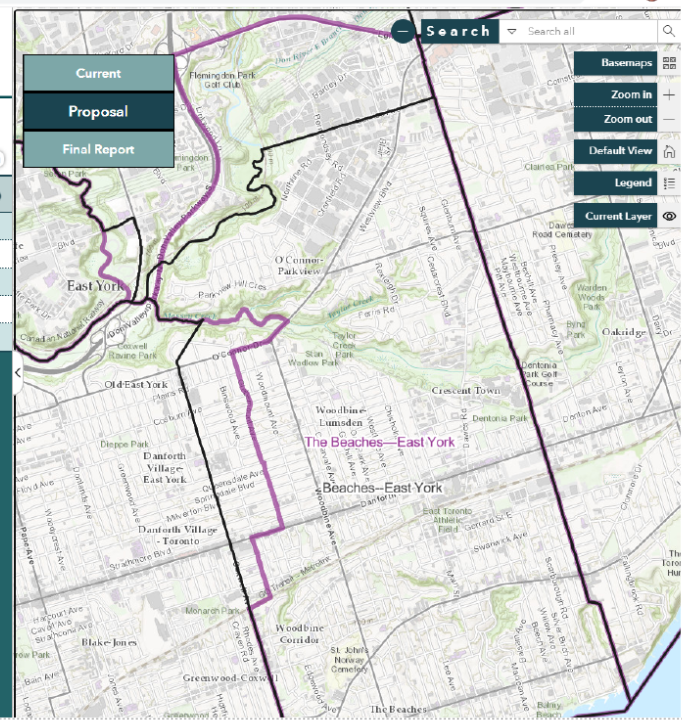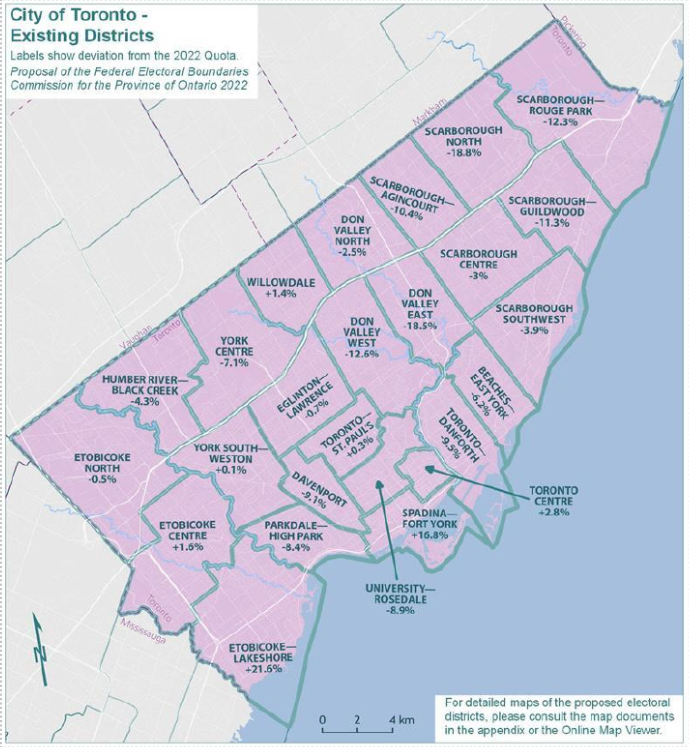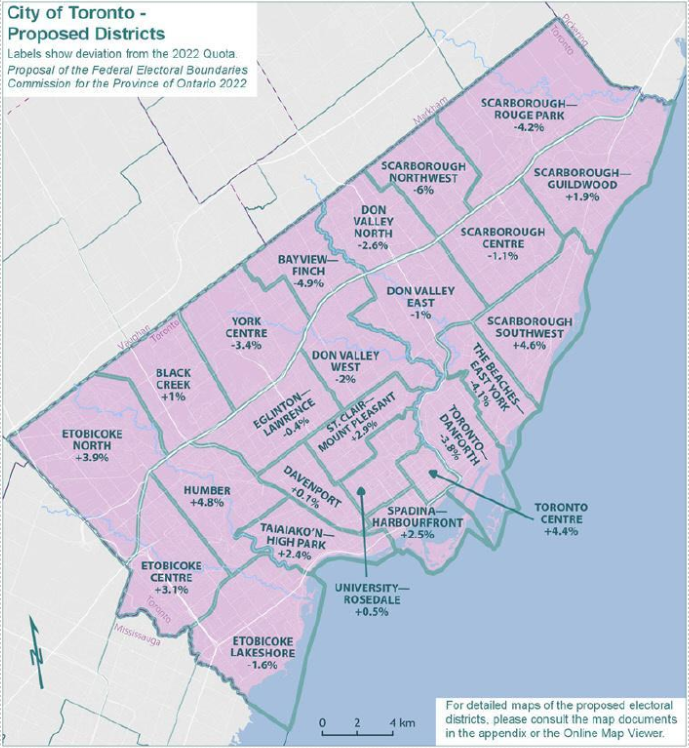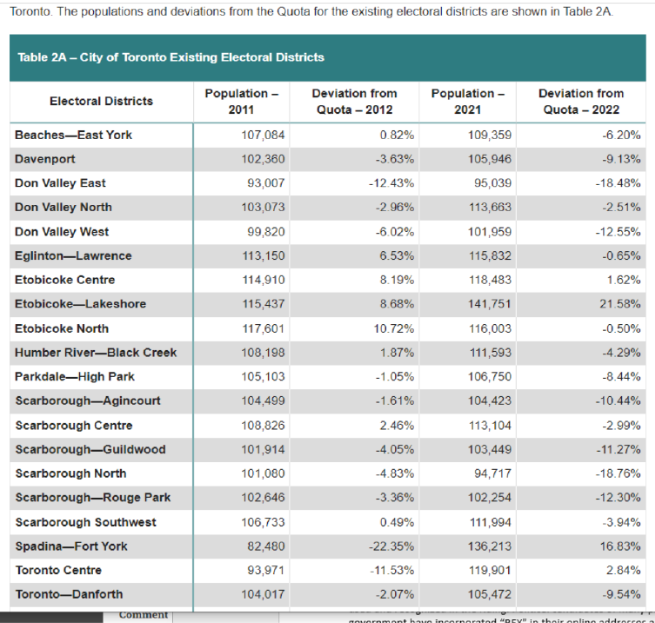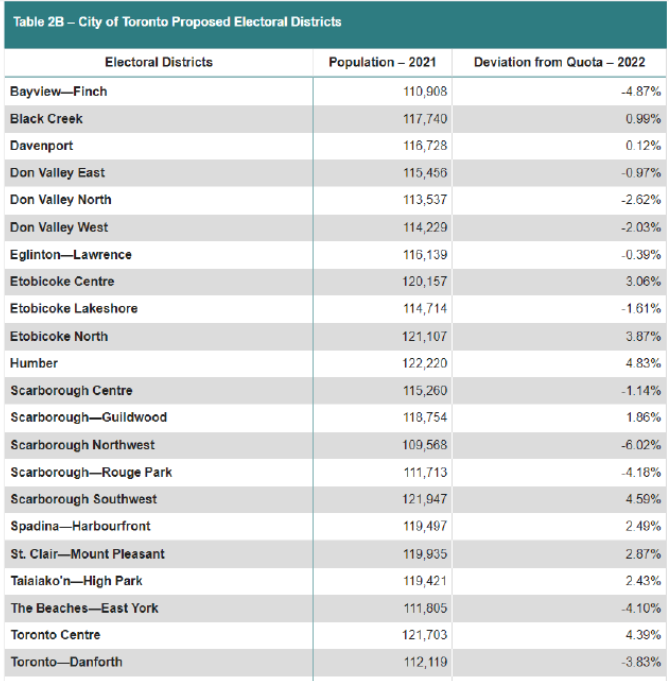Comment 164 – comments and feedback
Back to all comments and feedback from the public
Submission to the Electoral Boundaries Commission for the Province of Ontario
From Beaches-East York Federal and Provincial Riding Associations
The Federal and Provincial NDP Beaches-East York Riding Associations are pleased to participate in the decennial review of our Federal electoral boundaries, and wish to make this submission for your consideration.
We want to express our strong support for maintaining the existing boundaries of the Beaches - East York Riding and the existing number of ridings in the City of Toronto. We believe the existing boundaries of our riding generally reflect communities of interest, historic districts and geographic and natural features. The composition of the riding also reflects its name - with the Beaches in the south and East York in the north. We expect enhanced development and population growth in several areas of our riding will bring greater population and voter parity over the coming decade, and the existing boundaries will continue to serve its communities and constituents well until the next review. We urge the Commission to reconsider its proposed changes.
Previous boundary changes
Before considering any further changes to the boundaries, it is important for the Commission to recognize the results of the last review and the changes our communities have already accommodated. The 2012 review added areas to the north portion of the riding and rationalized the western boundary in the south. Prior to these changes, our riding included only portions of the legacy municipalities of the City of Toronto and the Borough of East York.
The 2012 changes added, for the first time, residents who lived in Don Valley East in the former municipality of North York. These residents found it difficult to relate to either the Beach or East York and the change was profoundly confusing. The clear boundary of Coxwell Avenue did, however, provide residents along the western border with greater clarity. Having held several elections with these boundaries, we believe affected neighbourhoods have accommodated the changes and generally know that they are part of Beaches-East York riding.
However, changing the riding boundaries as proposed would again create further confusion, fail to recognize communities of interest, natural or geographic boundaries, areas of anticipated growth and the history of our city. The riding name would no longer reflect the actual composition of the riding or provide a sense of location for many of the added neighbourhoods.
The Proposal for Beaches East York
The proposal makes significant changes to the northern and western borders, adding new neighbourhoods, dividing others, and changing existing geographic and natural boundaries. The proposed boundaries would:
- Move the northern boundary from Sunrise Avenue to Eglinton Avenue, adding a significant new portion of former North York along with new neighbourhoods, including parts of Victoria Village and Golden Mile neighbourhoods. This makes the riding exceptionally long and diverse, incorporating three former municipalities, from waterfront beaches and industrial portlands to suburban transit corridors, dense apartment neighbourhoods, employment lands and mature residential enclaves.
- Move the northerly section of the western boundary from the Don River to the Don Valley Parkway. This change, though seemingly inconsequential, moves the Linkwood Lane apartment neighbourhoods into Beaches- East York, separating it from Flemingdon Park, its adjacent neighbourhood. This change does not reflect the truly natural boundary of the Don River nor the existing neighbourhood patterns and connectivity.
- Move the western border two blocks east, from Coxwell Avenue to Glebemount Boulevard and Hillingdon Avenue to the CPR tracks. The change eliminates the clear geographic boundary of Coxwell Avenue and replaces it with a seemingly arbitrary jagged border along minor residential streets and a short portion of our main street, Danforth Avenue.
Impacts
Our BEY Riding Association believes that changing our riding boundaries through this review will cause unnecessary impacts on communities, and will not reflect geographic and natural features, historical voting patterns, and community identity and interests. While the changes may improve voter parity, it is our belief that population increases over the next 10 years will achieve this without additional change to the boundaries. We wish to provide the following to support our position.
Community Interest and Identity
The proposed boundary changes in the north part of the riding will add new suburban neighbourhoods from legacy North York, removing them from their traditionally identified districts and voting patterns. The change would force an amalgamation of communities with historically different interests and needs. The boundary fails to reflect the natural connections to adjacent neighbourhoods and the Don River and valley. The proposed riding name would not provide a meaningful identity to residents in these neighbourhoods.
Changes to the western boundary in the central portion of the riding seem arbitrary and shortsighted. The existing border along Coxwell Avenue is well-established, geographically-clear and easily understood by residents. This arterial road was confirmed by previous municipal and federal reviews as the logical boundary between the ridings of Beaches-East York and Toronto Danforth.
Removing a significant section of the grid-designed Danforth/Coxwell/Woodbine neighbourhood will be confusing to residents who have historically voted with their neighbours. The change will also be confusing for businesses and residents of two short blocks of Danforth Avenue who will be in different ridings on the north and south side of the street. This will be the only segment of Danforth Avenue that is divided between two ridings.
These changes will also contribute to a loss of community engagement and local influence as it will remove important institutions from our riding that have been the focus of local services and community advocacy such as East York Collegiate, Earl Beatty School and Community Centre, Kimbourne Church, Michael Garron Hospital, Coxwell Station and the TTC Coxwell Garage etc.
As MP Nathaniel Erskine-Smith stated in our community newspaper, The Beach Metro News, moving the boundary to Glebemount would cause "unnecessary confusion." MP Erskine-Smith states "For simplicity, Coxwell should remain the boundary."
Development and Population Growth
We understand the need for improved voter parity and greater equity through redistribution and quotas. We believe, however, that Beaches East York – and other ridings in Toronto- will achieve greater parity as development continues across the City.
In creating the proposed redistribution plan, "the Commission endeavoured to limit the deviation from the Quota to no more than plus or minus 10 per cent." The population of Beaches is currently -6.2per cent, within the 10% margin.
We also note that the formula for determining voter parity uses 2016 census data and Ontario 2021 population data projections. However, we believe the data may not recognize the anticipated development and growth arising from recently approved planning studies, provincial policies, and development proposals in our riding.
Over the next decade significant development will occur around higher order transit and other transit nodes. Beaches East-York will see significant development activity along all the "avenues" particularly along the TTC Danforth subway line and Metrolinx GO corridor, with significant density at Woodbine, Main and Dawes Road. Recent planning decisions have approved significant high-rise density for the areas north and south of the Danforth Go Station, and along Danforth Avenue. It is also anticipated that additional density will occur as recent official plan and zoning changes permit greater density in the "missing middle" residential neighbourhoods. The Eglinton Crosstown LRT will also spur growth along O'Connor Drive and other neighbourhoods in the northern part of the riding. The Toronto Community Housing community of Parma Court is slated for redevelopment. We believe all of these developments will result in fundamental changes to our communities and population.
Diversity, Democracy and Effective Representation
Our democracy relies on the legitimacy of both the process and outcomes of elections. In a world with growing cynicism and polarization in politics, it is even more important to sustain practices that contribute to voter confidence and encourage voter participation. We worry that unnecessary or inexplicable changes to ridings and voter identity can only contribute to a further weakening of our electoral system.
Toronto takes pride in its many diversities. Racial, language, and cultural diversity within neighbourhoods can enrich the lives of residents, communities, and our city. But too often these demographic characteristics are weighed down by systems of exclusion, poverty, and marginalization. Geographic and demographic differences also create very different needs and interests of residents, and create differing demands on government and its elected representatives.
According to a City of Toronto 2016 Census backgrounder, 1,266,005 or 47.0 per cent of the population of Toronto were immigrants, more than double the national average of 21.9 per cent. The census also found that 395,300 people living in Toronto are not yet Canadian citizens (14.7 per cent of the population). Residents who are not yet citizens often require significant support and advocacy from their elected officials.
While voter parity may be the primary goal of the review, the Commission should also take into account multiple factors that contribute to effective representation. A key 1991 Supreme Court of Canada decision recognized that effective representation can also consider "geography, community history, community interests and minority representation in order to effectively represent the diversity of our social mosaic."
Complex, urban ridings challenge the ability of elected officials to provide effective representation for their constituents. Reducing the number of ridings from 25 to 24 in Toronto, the most diverse City in North America, can only serve to weaken the ability of our MPs to deliver the effective representation they are elected to provide. According to a recent CBC report all Toronto MPs are concerned about the proposed reduction of one riding in our city.
Finally, the proposed name change from Beaches-East York to "The Beaches-East York" does not serve a meaningful purpose. The name of Beaches-East York and its acronym BEY is widely used and recognized in the riding. Political candidates of many parties and at all levels of government have incorporated "BEY" in their online addresses and social media handles. Changing the name would also make it more complicated to find information about the riding in an alphabetical list.
For the reasons presented above, our Riding Association requests that the Commission for Ontario leave the current riding boundary for Beaches-East York in its current form.
We appreciate the opportunity to provide feedback to the Commission. Please let us know if you would like more detail or any clarification of our position.
Sincerely,
Victoria Marshall, President,
Federal NDP Beaches-East York Riding Association
Elise Aymer, President,
Provincial NDP Beaches-East York Riding Association
